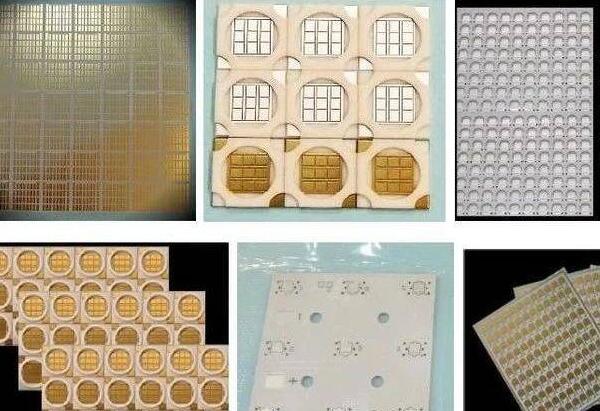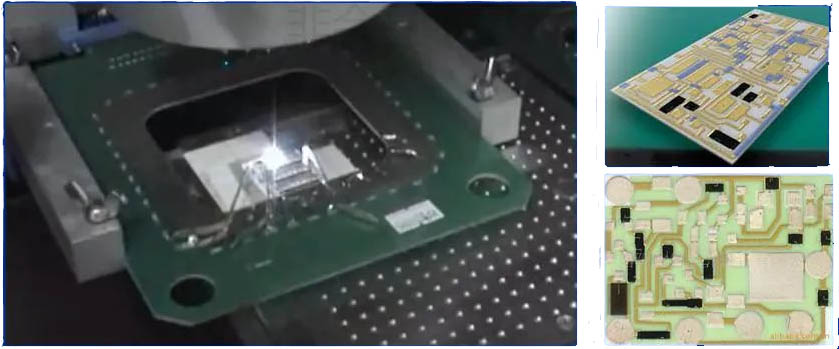The LTCC materials developed so far can be classified into three main categories in terms of material composition and structure.
Relative dielectric constants of different types of LTCC materials
1. LTCC materials are glass-ceramic systems, i.e., the precursor is a glass material, which crystallises during sintering and the crystalline phase precipitates out of the glass to form a self-growing two-phase structure. The volume fraction of the glass phase in this type of material is 50% to 80%. The glass phase is the main carrier of the functionality of these materials, while the small amount of crystalline components play a major role in improving the mechanical and thermal properties of the material.
This type of material is represented by Ferro A6 developed by Ferro Corporation of the United States, which is characterised by a homogeneous microstructure and is capable of achieving low dielectric constants and low losses, with guaranteed thermal and mechanical properties. Its disadvantage is that the material is single, and it is not easy to realise the regulation and serialization of the performance.
2.LTCC materials are ceramic-glass composite materials in the traditional sense, that is, using glass powder and crystalline ceramic powder as a precursor, sintered two-phase composite bulk materials. The volume fraction of the glass phase is 20% to 50%. The sintering properties are mainly determined by the glass phase, while the physical properties are determined by the glass phase and the crystalline phase. Typical representative of this type of material is DuPont 951 developed by DuPont, its advantage is that there is a certain performance control space.
3.LTCC material is called ‘glass bonded ceramics (Glass Bonded Ceramics)’, its precursor to the crystalline ceramic powder as the main body, adding low melting point ceramics as a co-firing agent. The structure is similar to that of a sintered ceramic in the traditional sense, except that the glass phase, which is the grain boundary, is slightly higher and generally accounts for 10% to 20% of the material (volume fraction).
The properties of these materials are mainly determined by the composition of the crystalline phases. There are many research reports on this type of material, but fewer practical applications have been achieved. This type of material is able to obtain a higher dielectric constant of the material, the performance of the adjustment of the space is also very large, the main problem is that has a strong role in supporting the burning of low-melting glass will be largely deteriorate the performance of the material.

LTCC
Advantages of LTCC material
1.Ceramic materials have excellent high-frequency, high-speed transmission and wide bandwidth characteristics. Ceramic materials have excellent high-frequency, high-speed transmission and wide bandwidth characteristics. According to the different ingredients, LTCC material dielectric constant can be changed in a wide range, with the use of high conductivity metal materials as a conductive material,is conducive to improving the quality of the circuit system factor, added flexibility in circuit design;
2.Can adapt to the requirements of high current and high temperature characteristics, and has a better thermal conductivity than ordinary PCB circuit board,greatly optimising the thermal design of electronic equipment, high reliability, can be used in harsh environments, extending its service life;
3.Can produce a very high number of layers of circuit board,and can be buried in a number of passive components,eliminating the cost of packaging components, in a very high number of layers of three-dimensional circuit substrate, the realization of passive and active integration,which is conducive to improving the circuit assembly density, and further reduce the volume and weight;
4.Good compatibility with other multilayer wiring technologies, e.g. combining LTCC with thin-film wiring technology can achieve higher assembly density and better performance of hybrid multilayer substrates and hybrid multi-chip assemblies;
5.Non-continuous production process facilitates quality inspection of each layer of wiring and interconnecting vias before the finished product is manufactured, which is conducive to improving the yield and quality of multilayer substrates, shortening the production cycle, and reducing costs.
6.Energy saving. Material saving Environmental protection has become an unstoppable trend in the development of the component industry, LTCC also meets this development demand, minimising raw materials, waste and environmental pollution brought about by the production process.

LTCC
Disadvantages of LTCC materials
1.Shrinkage problem.LTCC material there are many difficulties related to reliability,the substrate and wire co-firing shrinkage and thermal expansion coefficient matching problem is one of the important challenges, which is related to the quality of the multilayer metallised wiring.LTCC co-firing,the sintering characteristics of the substrate and paste mismatch is mainly manifested in three aspects:
Inconsistency in sintering densification completion temperature.
Inconsistent sintering shrinkage of substrate and paste.
Mismatch in sintering densification speed. These mismatches can easily lead to uneven surface after sintering.Warp.Delamination.Another consequence of the mismatch is that the adhesion of the metal wiring decreases.
2.Heat dissipation. Although the LTCC substrate than the traditional PCB board in the heat dissipation has been greatly improved,but due to the high degree of integration. The number of layers. Device operating power density is high, LTCC substrate heat dissipation is still a key issue, one of the determining factors affecting the stability of the system.
With the progress of microelectronics technology, the device working energy density is getting higher and higher, how to dissipate the heat in a timely and effective way to protect the stability of the device is the packaging of the difficult challenges faced. The use of high thermal conductivity materials and new package design is a common method to improve the heat dissipation efficiency of packaging components.
However, the obvious shortcoming of LTCC materials is the low thermal conductivity of the substrate (2-6W/m-K), which is much lower than that of the AlN substrate (≥100W/m-K), and much lower than that of the Al2O3 substrate (15-25W/m-K). This limits the application of LTCC materials in large. High-performance computer systems.